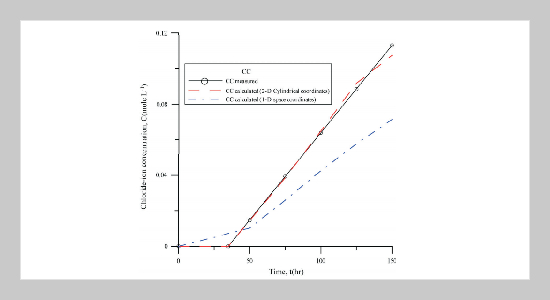REFERENCES
- [1]Dhir, R.K., Jones, M.R., Admed, H.E.H., “Concrete Durability : Estimation of Chloride Concentration during Design Life,” Magazine of Concrete Research,43, No154, pp.37-44 (1991).
- [2]Osborne, G.J., “Durability of Portland Blast-furnace Slag Cement Concrete,” Cement and Concrete Research, 21, pp.11-21 (1999).
- [3]Dhir, R.K.and Byars, E.A., ”PFA Concrete : Chloride Diffusion Rates,” Magazine of Concrete Research,45, No.162, pp.1-9 (1993).
- [4]Li, Z., Peng, J., Ma, B., “Investigation of Chloride Diffusion for High-performance Concrete Containing Fly Ash, Microsilica and Chemical Admixtures,” ACI Materials Journal,96, No.3, pp.391-396 (1999).
- [5]Page, C.L., Short, N.R., El Tarras, A., “Diffusion of Chloride Ions in Hardened Cement Pastes,” Cement and Concrete Research,11, No.3, pp.395-406 (1981).
- [6]Hansen, E.J. and Saouma, V.E., “Numerical Simulation of Reinforced concrete Deterioration-Part I : Chloride Diffusion,” ACI Materials Journal,96, No.2, pp.173-180 (1999).
- [7]Hansen, E.J. and Saouma, V.E., “Numerical Simulation of Reinforced Concrete Deterioration-Part II : Steel Corrosion and Concrete Cracking,” ACI Materials Journal,96, No.3, pp.331-338 (1999).
- [8]Shin, C.B. and Kim, E.K., “Modeling of Chloride Ion Ingress in Coastal Concrete,” Cement and Concrete Research, 32, pp.757-762 (2002).
- [9]ASTM C1202-97, ”Standard Test Method for Electrical Indication of Concrete’s Ability to Resist Chloride Ion Penetration,” American Society for Testing and Materials, (1994).
- [10]AASHTO T277-96 “Standard Method of Test for Rapid Determination of the Chloride Permeability of Concrete,” American Association of State Highway and Transportation Officials, Washington, DC, (1996).
- [11]Whiting, D., “Rapid Measurements of Chloride Permeability of Concrete,” Public Roads,45, No.3, pp.101-112 (1981).
- [12]Andrade, C., “Calculation of Chloride Diffusion Coefficients in Concrete from Ionic Migration Measurements,” Cement and Concrete Research,23, No.5, pp.724-742 (1993).
- [13]Cho, S. W., “Study of Chloride-Ion Transport Behavior in Cement-Based Composites Using Accelerated Chloride Migration Test,” D. Disertation, Institute of Material Engineering, National Taiwan Ocean University, Keelung, Taiwan, 161 pp. (2002). (in Chinese)
- [14]Cho, S. W., Yang, C. C., Huang, R., “Influence of Aggregate Content on the Transport Properties of Mortar Using Accelerated Chloride Migration Test,” Concrete Science and Engineering, Vol.4, 84-90 (2002).
- [15]Cho, S.W, Weng, T. L., Yang, C. C., Huang, R., “Using Accelerated Chloride Migration Teat to Study the Transport Phenomenon of Chloride Ion in Concrete Materials,”Journal of the Chinese Institute of Civil and Hydraulic Engineering, Vol.15 , No.1, 47-58(2003). (in Chinese )
- [16]Yang, C. C., Cho, S. W., Huang, R, “The Relationship between Charge Passed and the Chloride-Ion Concentration in Concrete Using Steady State Chloride Migration Test,” Cement and Concrete Research, Vol. 32, 217-222 (2002).
- [17]Yang, C. C., Cho, S. W., Chi, J. M., Huang, R., “An Electrochemical Method for Accelerated Chloride Migration Test in Cement Based Materials,” Materials Chemistry and Physics, Vol.77, 461-469 (2002).
- [18]Yang, C. C., “The Relationship between Charge Passed and the Chloride Concentration in Anode and Cathode Cells Using the Accelerated Chloride Migration Test,” Materials and Structures, Vol.36, 678-684 (2003).
- [19]Yang, C. C., Cho, S. W. “An Electrochemical Method for Accelerated Chloride Migration Test of Diffusion Coefficient in Cement-Based Materials,” Materials Chemistry and Physics, Vol.81, 116-125 (2003).
- [20]Yang, C. C., Cho, S. W. “The Relationship between Chloride Migration Rate for Concrete and Electrical Current in Steady State Using the Accelerated Chloride Migration Test,” Materials and Structures, Vol.37, 456-463 (2004).
- [21]Ou, L. H., “Theoretical and Experimental Studies on Transport Phenomenon of Chloride ion in Concrete Materials Using Accelerated Chloride Migration Test,” Master Thesis, Department of Harbor and River Engineering, National Taiwan Ocean University, Keelung, Taiwan, 74pp. (2005). (in Chinese)
- [22]O’Neil, P.V., Advanced Engineering Mathematics, 5th Edition, Brooks/Cole-Thomson Learning, Singapore, (2003).
- [23]Castellote, M., Andrade, C., Alonso, C., “Modeling of the Processes during Steady-state Migration Test : Quantification of Transference Numbers,” Materials and Structures,32, pp.180-196 (1999).
- [24]Byfors, K., “Influence of Silica Fume and Fly Ash on Chloride Diffusion and pH Values in Cement Pastes,” Cement and Concrete Research,17, pp.115-130 (1987).
















